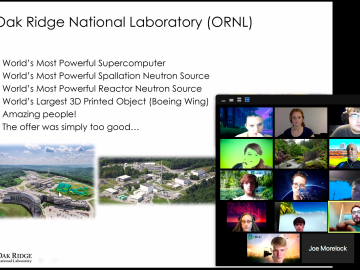
Filter News
Area of Research
- Advanced Manufacturing (5)
- Biology and Environment (17)
- Clean Energy (70)
- Climate and Environmental Systems (2)
- Computer Science (2)
- Energy Sciences (1)
- Fusion and Fission (6)
- Fusion Energy (5)
- Isotopes (5)
- Materials (52)
- Materials for Computing (5)
- National Security (15)
- Neutron Science (28)
- Nuclear Science and Technology (22)
- Nuclear Systems Modeling, Simulation and Validation (2)
- Quantum information Science (3)
- Supercomputing (38)
Date
News Topics
- 3-D Printing/Advanced Manufacturing (44)
- Advanced Reactors (17)
- Artificial Intelligence (33)
- Big Data (24)
- Bioenergy (23)
- Biology (18)
- Biomedical (27)
- Biotechnology (8)
- Buildings (15)
- Chemical Sciences (21)
- Clean Water (6)
- Climate Change (31)
- Composites (7)
- Computer Science (63)
- Coronavirus (23)
- Critical Materials (8)
- Cybersecurity (4)
- Decarbonization (22)
- Education (1)
- Emergency (1)
- Energy Storage (30)
- Environment (50)
- Exascale Computing (10)
- Fossil Energy (3)
- Frontier (9)
- Fusion (19)
- Grid (16)
- High-Performance Computing (20)
- Isotopes (19)
- ITER (1)
- Machine Learning (17)
- Materials (16)
- Materials Science (53)
- Mathematics (6)
- Mercury (1)
- Microelectronics (1)
- Microscopy (10)
- Molten Salt (2)
- Nanotechnology (19)
- National Security (20)
- Net Zero (6)
- Neutron Science (40)
- Nuclear Energy (41)
- Partnerships (15)
- Physics (19)
- Polymers (12)
- Quantum Computing (11)
- Quantum Science (26)
- Security (5)
- Simulation (14)
- Space Exploration (5)
- Statistics (2)
- Summit (23)
- Sustainable Energy (44)
- Transformational Challenge Reactor (5)
- Transportation (27)
Media Contacts

Horizon31, LLC has exclusively licensed a novel communication system that allows users to reliably operate unmanned vehicles such as drones from anywhere in the world using only an internet connection.

Pick your poison. It can be deadly for good reasons such as protecting crops from harmful insects or fighting parasite infection as medicine — or for evil as a weapon for bioterrorism. Or, in extremely diluted amounts, it can be used to enhance beauty.

Each summer for the last 30 years, students and teachers from across Appalachia have travelled to ORNL for a unique STEM summer camp experience – the Appalachian Regional Commission/ORNL Science-Technology-Mathematics Institute.

Oak Ridge National Laboratory scientists evaluating northern peatland responses to environmental change recorded extraordinary fine-root growth with increasing temperatures, indicating that this previously hidden belowground mechanism may play an important role in how carbon-rich peatlands respond to warming.

A UCLA-led team that discovered the first intrinsic ferromagnetic topological insulator – a quantum material that could revolutionize next-generation electronics – used neutrons at Oak Ridge National Laboratory to help verify their finding.

An all-in-one experimental platform developed at Oak Ridge National Laboratory’s Center for Nanophase Materials Sciences accelerates research on promising materials for future technologies.

Combining expertise in physics, applied math and computing, Oak Ridge National Laboratory scientists are expanding the possibilities for simulating electromagnetic fields that underpin phenomena in materials design and telecommunications.

Real-time measurements captured by researchers at ORNL provide missing insight into chemical separations to recover cobalt, a critical raw material used to make batteries and magnets for modern technologies.

Oak Ridge National Laboratory researchers have developed a machine learning model that could help predict the impact pandemics such as COVID-19 have on fuel demand in the United States.

ORNL has licensed two additive manufacturing-related technologies that aim to streamline and ramp up production processes to Knoxville-based Magnum Venus Products, Inc., a global manufacturer of fluid movement and product solutions for industrial applications in composites and adhesives.


